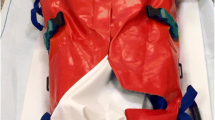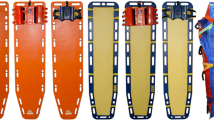Abstract
The objective of this study was the assessment of the image quality and radiation dose in polytrauma CT using immobilization devices. An anthropomorphic whole body and a liver phantom were scanned on a 128-slice CT scanner with four different protocols using automatic tube current modulation (120 kVp, 150 ref. mAs; 120 kV, 200 ref. mAs; 140 kVp, 150 ref. mAs; and 140 kVp, 200 ref. mAs) and four different setups (no immobilization device (setup A), vacuum mattress 1 (setup B), vacuum mattress 2 (setup C), and spineboard (setup D)). Qualitative and quantitative image quality parameters and radiation dose were assessed. Image noise increased on average by 6.6, 11.2, and 9.4 %, and CNR decreased by 11.2, 13.9, and 6.5 for setups B, C, and D, respectively, compared with setup A. The CTDIvol increased up to 6 % using immobilization devices. Severe streak artifacts, provoked by the inflation valve of the mattresses were detected at the level of the head and shoulder. Applying immobilization devices for whole-body CT with automatic tube current modulation increases the radiation dose and decreases the quantitative image quality slightly. Severe artifacts, induced by the inflation valve of the mattress, can influence the diagnostic accuracy at the level of the head and shoulder.





Similar content being viewed by others
References
Rieger M, Sparr H, Esterhammer R, Fink C, Bale R, Czermak B, et al. (2002) Modern CT diagnosis of acute thoracic and abdominal trauma. Radiologe 42(7):556–563
Huber-Wagner S, Lefering R, Qvick LM, Korner M, Kay MV, Pfeifer KJ, et al. (2009) Effect of whole-body CT during trauma resuscitation on survival: a retrospective, multicentre study. Lancet 373(9673):1455–1461
Sierink JC, Treskes K, Edwards MJ, Beuker BJ, den Hartog D, Hohmann J, et al. (2016) Immediate total-body CT scanning versus conventional imaging and selective CT scanning in patients with severe trauma (REACT-2): a randomised controlled trial. Lancet 388(10045):673–683
Schurink GW, Bode PJ, van Luijt PA, van Vugt AB (1997) The value of physical examination in the diagnosis of patients with blunt abdominal trauma: a retrospective study. Injury 28(4):261–265
Schou J, Kiermayer H, Ummenhofer W, Herion HP (2001) In search of the most suitable technique for truncal spinal immobilization with associated radiography. Eur J Emerg Med 8(2):89–92
Linsenmaier U, Krotz M, Kanz KG, Russ W, Papst E, Rieger J, et al. (2001) Evaluation of spine boards for X-ray diagnostics. RoFo: Fortschritte auf dem Gebiete der Rontgenstrahlen und der Nuklearmedizin 173(11):1041–1047
Kahn J, Grupp U, Kaul D, Boning G, Lindner T, Streitparth F (2016) Computed tomography in trauma patients using iterative reconstruction: reducing radiation exposure without loss of image quality. Acta Radiol 57(3):362–369
Rizzo S, Kalra M, Schmidt B, Dalal T, Suess C, Flohr T, et al. (2006) Comparison of angular and combined automatic tube current modulation techniques with constant tube current CT of the abdomen and pelvis. AJR Am J Roentgenol 186(3):673–679
Kalra MK, Maher MM, Toth TL, Schmidt B, Westerman BL, Morgan HT, et al. (2004) Techniques and applications of automatic tube current modulation for CT. Radiology 233(3):649–657
Niemann T, Zbinden I, Roser HW, Bremerich J, Remy-Jardin M, Bongartz G (2013) Computed tomography for pulmonary embolism: assessment of a 1-year cohort and estimated cancer risk associated with diagnostic irradiation. Acta Radiol 54(7):778–784
The 2007 Recommendations of the International Commission on Radiological Protection (2007) ICRP publication 103. Ann ICRP 37(2–4):1–332
Kotsenas AL, Michalak GJ, DeLone DR, Diehn FE, Grant K, Halaweish AF, et al. (2015) CT metal artifact reduction in the spine: can an iterative reconstruction technique improve visualization? AJNR Am J Neuroradiol 36(11):2184–2190
Higashigaito K, Angst F, Runge VM, Alkadhi H, Donati OF (2015) Metal artifact reduction in pelvic computed tomography with hip prostheses: comparison of virtual monoenergetic extrapolations from dual-energy computed tomography and an iterative metal artifact reduction algorithm in a phantom study. Investig Radiol 50(12):828–834
Author information
Authors and Affiliations
Corresponding author
Ethics declarations
Conflict of interest
The authors declare that they have no conflict of interest.
Disclosures
André Euler and Bram Stieltjes have nothing to disclose.
Sebastian T. Schindera received a grant from Siemens Healthcare and a grant from Bayer Healthcare.
Additional information
IRB approval was not needed because of the study design as a phantom study.
Rights and permissions
About this article
Cite this article
Euler, A., Stieltjes, B. & Schindera, S.T. Automatic tube current modulation for whole-body polytrauma CT with immobilization devices: is there an increase in radiation dose and degradation of image quality?. Emerg Radiol 24, 31–37 (2017). https://doi.org/10.1007/s10140-016-1442-x
Received:
Accepted:
Published:
Issue Date:
DOI: https://doi.org/10.1007/s10140-016-1442-x




